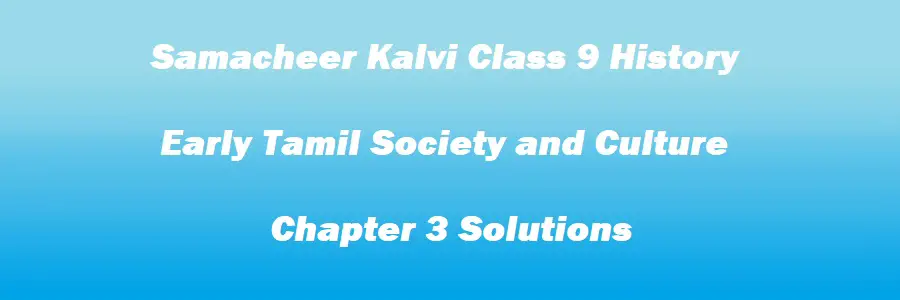Samacheer Kalvi Class 9 History Chapter 3 Early Tamil Society and Culture Solutions
Welcome to NCTB Solutions. Here with this post we are going to help 9th class students by providing Solutions for Samacheer Kalvi Class 9 History Chapter 3 Early Tamil Society and Culture. Here students can easily find all the solved solution for class 9 Social Science, History Chapter 3, Early Tamil Society and Culture Exercise questions. Also here our expert History Teacher’s solved all the questions with easily understandable language with proper guidance so that all the students can understand easily. Here on this post students will get Chapter 3 Early Tamil Society and Culture exercise solutions. Here all the solutions are based on Tamil Nadu State Board latest syllabus.

Early Tamil Society and Culture Chapter 3 Solutions :
(I) Choose the correct Answer
(1) The name of the script used in the Sangam Age
(a) English
(b) Devanagari
(c) Tamil-Brahmi
(d) Granta
Answer :
Correct Option → (c)
Tamil-Brahmi used in the Sangam Age.
(2) The Sri Lankan chronicle composed in the Pali language mentioning about merchants and horse traders from Tamil Nadu
(a) Deepa vamsa
(b) Arthasastra
(c) Mahavamsa
(d) Indica
Answer :
Correct Option → (c)
The Sri Lankan chronicle composed in the Pali language mentioning about merchants and horse traders from Tamil Nadu Mahavamsa.
(3) The notable Chola king credited with bringing forest lands under the plough and developing irrigational facilities
(a) Karikalan
(b) Rajarajan I
(c) Kulothungan
(d) Rajendran I
Answer :
Correct Option → (a)
The notable Chola king credited with bringing forest lands under the plough and developing irrigational facilities Karikalan.
(4) Inscription that mentions the Cheras
(a) Pugalur
(b) Girnar
(c) Pulimankombai
(d) Madurai
Answer :
Correct Option → (a)
The inscription that mentions the Cheras Pugalur.
(5) The famous Venetian traveller who described Kayal as a great and noble city
(a) Vasco da gama
(b) Alberuni
(c) Marco Polo
(d) Megasthenes
Answer :
Correct Option → (a)
Marco Polo described Kayal as a great and noble city.
(6) – (i) Coins as a medium of exchange were introduced for the first time in the Sangam Age.
(ii) Prakrit was the language used by the common people in Northern India during the Mauryan period.
(iii) Vienna Papyrus, a Roman document, mentions trade related to Muziri.
(iv) The concept of Thinai is presented in the Tamil grammar work of Pathupaattu.
(a) (i) is correct
(b) (ii) is correct
(c) (i) and (ii) is correct
(d) (iii) and (iv) is correct
Answer :
Correct Option → (c)
Because most of the people was spoken in prakit language. It was use in northern Indian and coin was medium of exchange in sangam period age.
(7) – (i) Pathitrupathu speaks about the Pandya kings and their territory.
(ii) The Akanaanuru describes the trading activities at Kaveripoompattinum.
(iii) The Chola Emblem was the tiger and they issued square copper coins with images of a tiger.
(iv) Neythal is a sandy desert region.
(a) (i) is correct
(b) (ii) and (iii) is correct
(c) (iii) is correct
(d) (iv) is correct
Answer :
Correct Option → (c)
The Chola Emblem was the tiger and they issued square copper coins with images of a tiger.
(II) Fill in the blanks
(2) __ refers to systematically digging a site to recover material evidence for exploring societies of the past.
(3) __ the classic work of economy and statecraft authored by Kautilya during the Mauryan period
(4) __ is a poetic theme which means a class or category and refers to habitat or eco-zone with specific physiographical characteristics.
(5) __ referred to the Westerners, including the Greeks, Romans, and West Asian people.
Answer :
(2) → Archaeological excavation
(3) → Arthasastra
(4) → Thinai
(5) → Yavanar
(III) Find out the correct statement
(a) Evidence of iron smelting has been found in Kodumanal and Guttur.
(b) Periplus of Erythren Sea mentions the pepper trade with India.
(c) Punch marked coins are the earliest coins used in India mostly made of gold.
(d) The Sangam Age has its roots in the Bronze Age.
Answer :
Correct Option → (a)
Evidence of iron smelting has been found in Kodumanal and Guttur.
(2) – (a) The Cheras ruled over the Kaveri delta and their capital was Uraiyur.
(b) The Maangulam Tamil-Brahmi inscriptions mention the King Karikalan.
(c) The terms Vanikan and Nigama appear in Tamil-Brahmi inscriptions were different types of merchants.
(d) Salt merchants were called Vanikars and they travelled in bullock carts along with their family.
Answer :
Correct Option → (c)
The terms Vanikan and Nigama appear in Tamil-Brahmi inscriptions were different types of merchants.
(IV) Match the following
(1) Epigraphy – a narrative text presenting the important historical events
(2) Chronicle – a Sangam Age port
(3) Pastoralism – an ornament made in precious stone.
(4) Cameo – the study of inscriptions
(5) Arikkamedu – nomadic people earning livelihood by rearing cattle.
Answer :
(1) Epigraphy → the study of inscriptions
(2) Chronicle → a narrative text presenting the important historical events
(3) Pastoralism → nomadic people earning a livelihood by rearing cattle.
(4) Cameo → an ornament made in a precious stone.
(5) Arikkamedu → a Sangam Age port
Next Chapter Solution :